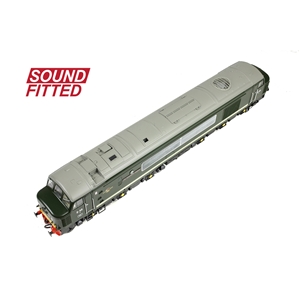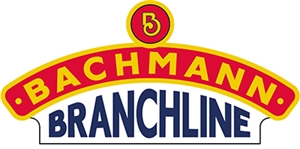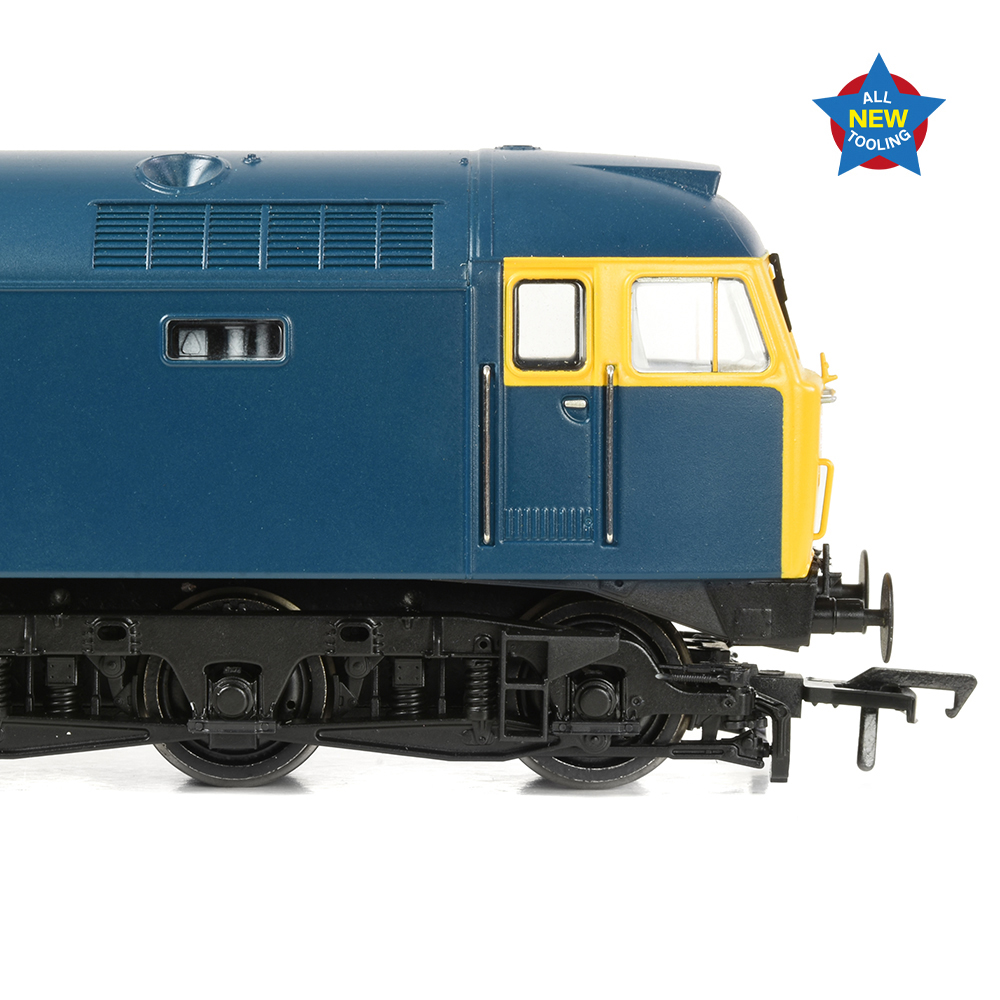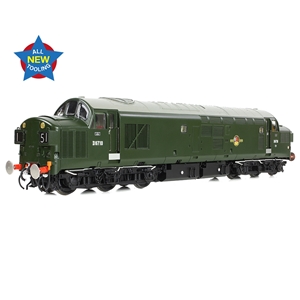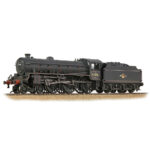The popular Class 45 Diesel Locomotive returns to the Bachmann Branchline range with this OO scale model depicting No. D49 ‘The Manchester Regiment’. Together with the Class 44s and 46s the classes were commonly known as the ‘Peaks’, because the Class 44s had been named after mountains in England and Wales, however those Class 45s that were named were after British Army Regiments and the Royal Marines. No. D49 is one such named example, being named after the Manchester Regiment of the British Army.
The Bachmann Branchline model combines a finely-proportioned bodyshell with extensive detailing throughout, including separately fitted cab handrails, windscreen wipers, lamp brackets and sandpipes. With a powerful 5-pole motor fitted with twin flywheels which drives both bogies, these models have plenty of pulling power to haul even the longest trains. This model is supplied with SOUND FITTED, allowing realistic sound effects to be enjoyed on both DCC or Analogue Control straight out of the box!
MODEL FEATURES:
- Bachmann Branchline OO Scale
- Era 5
- Pristine BR Green (Small Yellow Panels) livery
- Running No. D49
- Named ‘The Manchester Regiment’
- Etched Nameplates included
- Split Centre Headcode Panels displaying headcodes 1C58 and 1N78
- NEM Coupling Pockets
- Sprung Buffers
- Powerful 5 Pole Motor with Twin Flywheels
- Detailed Cab Interior with pre-fitted Driver in one cab
- Directional Lighting
- Accessory Pack
- SOUND FITTED – Fitted with a ESU V5DCC Sound Decoder – See below for the function list
- Length 275mm
SOUNDS
F0 – Directional Lights – On/Off (plus Light Switch Sound)
F1 – On – Fuel Pump On – Warm Engine Start
F1 – On/Off – Fuel Pump On – Failed Engine Start Latch Single
F1 – On/Off/On – Fuel Pump On – Cold Engine Start
F2 – Brake
F3 – Single Horn (Playable)
F4 – Two-Tone Horn
F5 – Drive Hold (also known as Speed Lock)
F6 – Coasting
F7 – Coupling Up & Brake Pipe Connect
F8 – Uncoupling, Brake Disconnect & Vac Destroyed
F9 – Flange Squeal
F10 – Air Dump
F11 – Spirax Valve
F12 – On – Guard’s Whistle / Off – Driver’s Response
F13 – N/A
F14 – Auto Uncouple Cycle Latch –
F15 – On – Driver’s Door Open / Off – Driver’s Door Shut
F16 – AWS Horn
F17 – AWS Bell
F18 – Windscreen Wipers
F19 – Latch – Mute / Trigger – Cycle through 6 Volume Levels
Analogue Users: Directional lights and basic Prime Mover (engine) sounds, which vary with speed, plus any other automated sounds, can be enjoyed when using this model on analogue control (DC) straight from the box!
CLASS 45 HISTORY
The 127 British Rail Class 45s, also known as the BR-Sulzer Type 4 diesel locomotives, were built by British Railways’ Derby and Crewe Works between 1960 and 1962. Along with the similar Class 44 and Class 46 locomotives, they became known as ‘Peaks’. The Class 45s began their lives with a variety of nose ends, incorporating gangway end doors flanked by split headcode boxes (Nos. D11-D15), split headcode boxes but no gangway doors (a group each of Crewe and Derby examples) and twin headcode panels situated in the centre of the nose (the later-built Derby and Crewe specimens). Numerous locos transitioned through a single central headcode panel phase (akin to the Class 46s), before the majority received plated over nose ends with sealed beam headlights in the 1970s. ETH-fitted survivors of Class 45/1 received high intensity headlights in the mid-1980s. Liveries worn were standard BR lined green, ‘austerity’ green without the cream embellishments of the original livery, and BR blue, a few with small yellow panels, and ultimately the entire class with full yellow ends.
Class 45s became the main traction on the Midland Main Line from 1962, and their introduction allowed considerable acceleration of the previously steam-powered services. The Class 45s remained the main source of power on the Midland Main Line up to 1982, when they were relegated to secondary services following introduction of HSTs on the route. From 1986, Class 45s virtually disappeared from the line. From the early 1980s until their final withdrawal in 1988, the Class were regular performers on the North Trans-Pennine line, working services from Liverpool Lime Street to York, Scarborough or Newcastle via Manchester Victoria, Huddersfield and Leeds. These trains were usually formed of early-type BR Mk2 carriages, of up to seven in a typical train.
The Class 45s also worked several named expresses including the Thames-Clyde and Thames-Forth, also known as The Waverley, on the much-lamented route from Carlisle to Edinburgh via Hawick. Class 45 No. D60 ‘Lytham St Annes’, later No. 45022, is famous for working the final service train over the Waverley route before it closed on 6th January 1969, this being the final Edinburgh to St Pancras sleeping car service.


